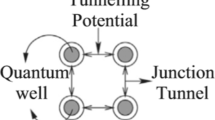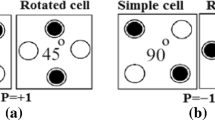Abstract
Quantum-dot cellular automata (QCA) are a new technology used to fabricate digital circuits on the nanoscale in place of CMOS technology, which has limitations in device density. QCA devices are low in power consumption and high in speed due to their structure. Although some defects may occur during chemical fabrication, QCA gates and circuits can be designed to be fault-tolerant. The majority gate is most often used in QCA circuits; thus, many papers have investigated different structures for it and tried to design a fault-tolerant gate against only one defect. We have proposed a new structure for a three-input majority gate with a good percentage of truth output despite the multiple defects that may take place concurrently. A full adder is then designed using the proposed majority gate to demonstrate the degree of fault tolerance of QCA circuits made of fault-tolerant gates.




















Similar content being viewed by others
References
50 years of Moore’s law, Intel’s Silicon Innovations. http://www.intel.in/content/www/in/en/silicon-innovations/moores-law-technology.html. Accessed 20 Feb 2020
Lent CS, Tougaw PD, Porod W, Bernstein GH (1993) Quantum cellular automata. Nanotechnology 4(1):49
Javid M, Mohamadi K (2009) Characterization and tolerance of QCA full adder under missing cells defects. In: Fifth International Conference on MEMS, NANO and Smart Systems (ICMENS)
Raj M, Kumaresan RS, Gopalakrishnan L (2019) Optimized multiplexer and XOR gate in 4-dot 2-electron QCA using novel input technique. In: 10th International Conference on Computing, Communication and Networking Technologies
Wang X, Xie GJ, Deng F (2018) Design and comparison of new fault-tolerant majority gate based on quantum dot cellular automata. J Semicond 39(8):085001
Danehdaran F, Angizi S, Khosroshahy MB, Navi K, Bagherzadeh N (2019) A combined three and five inputs majority gate-based high performance coplanar full adder in quantum-dot cellular automata. Int J Inf Technol. https://doi.org/10.1007/s41870-019-00365-z
Sun M, Lv H, Zhang Y, Xie G (2018) The fundamental primitives with fault-tolerance in quantum-dot cellular automata. J Electron Test 34:109–122
Farazkish R (2014) A new quantum dot cellular automata fault tolerant five input majority gate. J Nanopart Res 16(2):2259
Sasamal TN, Mohan A, Singh AK (2020) Optimal realization of full adder in QCA using 5-input majority gate. In: IEEE International Conference on Industry 4.0 Technology (I4Tech)
Hashemi S, Azghadi MR, Navi K (2019) Design and analysis of efficient QCA reversible adders. J Supercomput 75:2106–2125
Cocorullo G, Corsonello P, Frustasi F, Perri S (2017) Design of efficient BCD adders in quantum dot cellular automata. IEEE Trans Circuits Syst II Express Briefs 64(5):575–579
Babaie S, Sadeghifar A, Bahar AN (2019) Design of an efficient multilayer arithmetic logic unit in QCA. IEEE Trans Circuits Syst II Express Briefs 66:963–967
Ahmadpour SS, Mosleh M, Heikalabad SR (2018) A revolution in nanostructure designs by proposing a novel QCA full-adder based on optimized 3-input XOR. Physica 550:383–392
Abedi D, Jabripur G (2018) Decimal full adders specially designed for QCA. IEEE Trans Circuits Syst II Express Briefs 65(1):106–110
Singh G, Raj B, Sarin R (2018) Fault-tolerant design and analysis of QCA-based circuits. IET Circuits Devices Syst 12:638–644
Sabbaghi-Nadooshan R, Kianpour M (2014) A novel QCA implementation of MUX-based universal shift register. J Comput Electron 13(1):198–210
Das B, Mahmood M, Rabeya M, Bardhan R (2019) An effective design of 2:1 multiplexer and 1:2 demultiplexer using 3-dot QCA architecture. In: International Conference on Robotics, Electrical and Signal Processing Techniques (ICREST)
Mohammadi Z, Navi K, Sabbaghi-Nadooshan R (2020) Design of testable reversible latches by using a novel efficient implementation of Fredkin gate. Int J Electron 107(6):859–878
Ahmadpour SS, Mosleh M, Heikalabad SR (2020) The design and implementation of a robust single-layer QCA ALU using a novel fault-tolerant three-input majority gate. J Supercomput 76:10155–10185
Sadhu A, Das K, De D, Kanjilal MR (2020) Area-delay-energy aware SRAM memory cell and M × N parallel read/write memory array design for quantum dot cellular automata. Microprocess Microsyst 72:102944
Moghimizadeh T, Mosleh M (2019) A novel design of fault-tolerant RAM cell in quantum-dot cellular automata with physical verification. J Supercomput 75:5688–5716
Sardinha L, Costa A, Neto O, Vieira L, Vieira M (2013) NanoRouter: a quantum-dot cellular automata design. IEEE J Sel Areas Commun 31(12):825–834
Yang X, Cai L, Wang S, Wang Z, Feng C (2012) Reliability and performance evaluation of QCA devices with rotation cell defect. IEEE Trans Nanotechnol 11(5):1009–1018
Mukherjee R, Tripathi S, Sen S, Sen B (2016) Characterization and analysis of single electron fault of QCA primitives. In: International Conference on Microelectronics, Computing and Communications (MicroCom)
Farazkish R, Sayedsalehi S, Navi K (2012) Novel design for quantum dots cellular automata to obtain fault tolerant majority gate. J Nanotechnol 2012:943406
Blair E, Lent C (2018) Clock topologies for molecular quantum-dot cellular automata. J Low Power Electron 8(3):31
Huang J, Momenzadeh M, Schiano L, Ottavi M, Lombardi F (2005) Tile-based QCA design using majority-like logic primitives. JETC 1(3):163–185
Lent CS, Tougaw PD (1997) A device architecture for computing with quantum dots. Proc IEEE 85:541–557
Walus K, Tysart TJ, Jullien GA, Budiam RA (2004) QCADesigner: a rapid design and simulation tool for quantum-dot cellular. IEEE Trans Nanotechnol 3(1):26–31
Acknowledgements
This work was supported by IPM grant.
Funding
The funding was provided by Institute for Research in Fundamental Sciences.
Author information
Authors and Affiliations
Corresponding author
Additional information
Publisher's Note
Springer Nature remains neutral with regard to jurisdictional claims in published maps and institutional affiliations.
Rights and permissions
About this article
Cite this article
Foroutan, S.A.H., Sabbaghi-Nadooshan, R., Mohammadi, M. et al. Investigating multiple defects on a new fault-tolerant three-input QCA majority gate. J Supercomput 77, 8305–8325 (2021). https://doi.org/10.1007/s11227-020-03567-6
Accepted:
Published:
Issue Date:
DOI: https://doi.org/10.1007/s11227-020-03567-6




